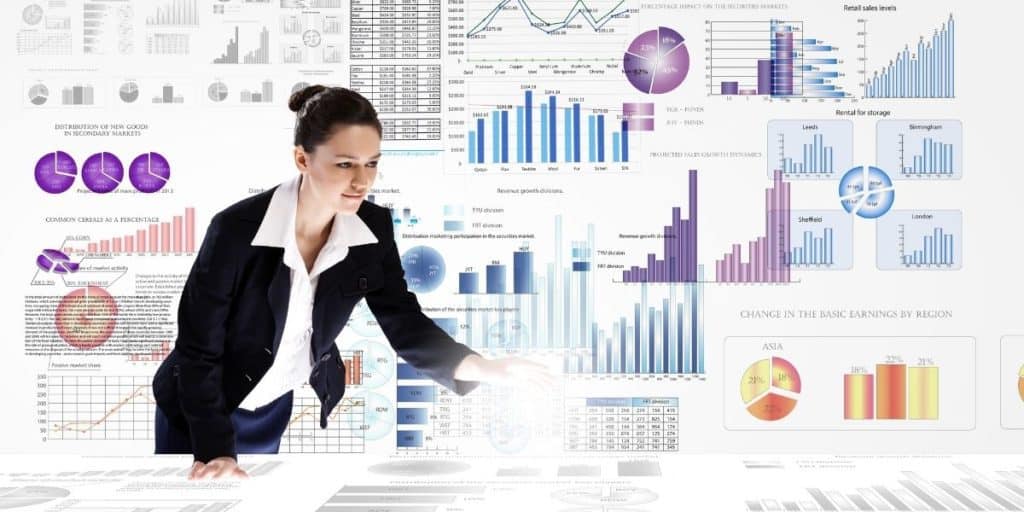Presenting and sharing data with your company’s associates can be a daunting task to those new to database management. If this sounds like you, the Tableau software may be right up your alley. But is there a lot of programming involved in making it work?
Tableau is not a programming language. Furthermore, it runs a programming language in the background that makes data presentation as simple as dragging and dropping. Data literacy may help you understand how Tableau works since its software engine, VizQL, works with Structured Query Language.
Read on to learn more about programming languages, Tableau Software, and how they differ.
Important Sidenote: We interviewed numerous data science professionals (data scientists, hiring managers, recruiters – you name it) and identified 6 proven steps to follow for becoming a data scientist. Read my article: ‘6 Proven Steps To Becoming a Data Scientist [Complete Guide] for in-depth findings and recommendations! – This is perhaps the most comprehensive article on the subject you will find on the internet!
Table of Contents
What is a Programming Language?
‘Programming language’ is an intimidating term. Still, it breaks down like this: a programming language is a tool that creates instructions for a computer to follow. This definition is a great place to start, but what does it mean? Let’s take a look at computers. A computer’s job is to input and output information. It completes tasks by analyzing and organizing data. These tasks often repeat themselves.

There are all kinds of computers out there. We are not only referring to a desktop or laptop. Smartphones, tablets, gaming consoles, and even your microwave contain a computer, which is only the beginning! What do all of these computers have in common? It is a language you might have heard of before: binary code.
Binary code is a language dictated into numerals: 1 and 0. ‘0’ represents ‘on,’ and ‘1’ means ‘off.’ These numerals correspond to the billions of switches contained in a CPU chip. When all of these switches are combined, it creates data and instructions for completing tasks and calculations.
If binary code sounds complicated, that is because it is. While this language is native to computers, it is too abstract for humans to comprehend. Programming languages translate binary code into information that is more digestible to us.
There are two types of programming languages: low-level and high-level.
- A low-level programming language is a machine-level language that is closer to binary code. It is still relatively hard to understand. However, the language benefits from being faster and more precise.
- A high-level programming language operates similarly to human communication. These languages use everyday words, like ‘run,’ ‘order,’ and ‘request,’ to name a few. They benefit from being much more comfortable to interpret than binary or a low-level language. However, being further from binary code, they take more time to translate.
The difference in processing time between low and high-level programming languages is negligible, amounting to bare milliseconds. Therefore, you will get the same results from high-level languages as you would from a low-level language. Programmers can complete most jobs with high-level languages.
Programming languages are tools, and each language works differently and is suited to different tasks. For example, if you are developing an app for iOS or macOS, the best language for you would be Swift, a language created for Apple.
There are many programming languages out there, so we will not go over all of them. However, we will give you some examples of languages used by data scientists:
- R is a prevalent programming language in academia and tech companies. However, it is an entry-level language for answering questions using data analytics, visualizations, and data science. It is well known for being very beginner-friendly.
- Python is another great beginner’s programming language, and more versatile than R, which is more oriented to data sciences. It covers multiple tasks, including web development, machine learning, and data science, among other tasks. Its outstanding reputation comes from how concise and easy to read it is.
- SQL, or Structured Query Language, is a programming language intended for relational data management. Relational data management pertains to databases that are related to each other. Relational databases often present themselves in tables. Relational database management is how you create, administer, and update relational databases. If you wish to be data-literate, SQL is the language to learn.
What Is Tableau Software?
The Tableau platform is a data analytics program used for business management and intelligence. Compared to other data analytics programs that require a programming background, Tableau provides a user-friendly interface that anyone can use.
Tableau can connect and prepare your data, no matter the size or file format. Furthermore, the program translates data files, whether cloud-based, on-premises, or flat. Tableau features hybrid connectivity, which covers live data analysis and in-memory data analysis from encrypted sources.
Tableau Prep, a product of the Tableau suite, offers a smooth visual interpretation of data.
Another boon of the Tableau suite is its ability to understand data more efficiently. Tableau offers a seamless environment that is more interactive than the normal stop-and-go process of data reporting.
The visual interpretations of the desktop app provide part of Tableau’s interactivity. This feature is very significant for encouraging critical thinking and decision-making driven by data.
Tableau Desktop gives users the agency to build their visualizations with drag-and-drop tools. Additionally, users can develop statistical modeling via AI technology with the click of a mouse. Lastly, users can ask questions about the data with natural language.
Secure sharing from an accessibility perspective is a priority of Tableau products. Tableau Server and Tableau Online both provide data sharing services on-premises and in the cloud. Additionally, Tableau Online takes out the extra work of managing data servers. For on-the-go analytics, Tableau also has a mobile app compatible with iOS and Android.
Tableau is not a one-size-fits-all product. The company goes the extra mile to provide role-specific licensing tailored to skill level and responsibilities:
- Creators assemble the analytical content. Their responsibilities include designing, cleaning, and curating data sources via dashboards and visual aids.
- Explorers can access the content made by creators, analyze that data, and create and share dashboards of their own (contingent on governed authoring).
- Viewers are the least hands-on party. This role can view and interact with data, with the ability to subscribe to updates and alerts.
Is Tableau Software a Programming Language?
Tableau analyzes, manages, and presents data. A programming language translates data. Does this mean Tableau is a programming language? The short answer is no. Tableau does use a programming language to decrypt the data. However, this programming gets done by the software itself, not the stop-user. That’s the beauty of Tableau: it is a data analytics software that requires virtually no programming skills to run.
What programming language does Tableau use in the background? This language is VizQL. Remember when we discussed SQL or Structured Query Language? VizQL stands for Visual Query Language. You may have gathered by now that these two languages work hand in hand. The VizQL intakes SQL expressions and outputs the information in an easy-to-read visual format.

VizQL contains the standard commands found in most relational data management languages, like ‘where,’ ‘group by,’ and ‘order by.’ However, VizQL stands out from the pack by providing syntax that instructs how to organize the data into a table with rows and columns. This syntax makes visually presenting data as simple as dragging and dropping data from SQL. The accessibility in Tableau’s features is due to the seamless qualities of VizQL.
Author’s Recommendations: Top Data Science Resources To Consider
Before concluding this article, I wanted to share few top data science resources that I have personally vetted for you. I am confident that you can greatly benefit in your data science journey by considering one or more of these resources.
- DataCamp: If you are a beginner focused towards building the foundational skills in data science, there is no better platform than DataCamp. Under one membership umbrella, DataCamp gives you access to 335+ data science courses. There is absolutely no other platform that comes anywhere close to this. Hence, if building foundational data science skills is your goal: Click Here to Sign Up For DataCamp Today!
- IBM Data Science Professional Certificate: If you are looking for a data science credential that has strong industry recognition but does not involve too heavy of an effort: Click Here To Enroll Into The IBM Data Science Professional Certificate Program Today! (To learn more: Check out my full review of this certificate program here)
- MITx MicroMasters Program in Data Science: If you are at a more advanced stage in your data science journey and looking to take your skills to the next level, there is no Non-Degree program better than MIT MicroMasters. Click Here To Enroll Into The MIT MicroMasters Program Today! (To learn more: Check out my full review of the MIT MicroMasters program here)
- Roadmap To Becoming a Data Scientist: If you have decided to become a data science professional but not fully sure how to get started: read my article – 6 Proven Ways To Becoming a Data Scientist. In this article, I share my findings from interviewing 100+ data science professionals at top companies (including – Google, Meta, Amazon, etc.) and give you a full roadmap to becoming a data scientist.
Conclusion
In short, while Tableau uses a programming language in its software, it is not a language in and of itself. A programming language translates binary code into more understandable terms, allowing programmers to instruct computers more intuitively. On the other hand, Tableau utilizes VizQL, a programming language that intakes SQL information and presents it in a clear and concise visual format.
BEFORE YOU GO: Don’t forget to check out my latest article – 6 Proven Steps To Becoming a Data Scientist [Complete Guide]. We interviewed numerous data science professionals (data scientists, hiring managers, recruiters – you name it) and created this comprehensive guide to help you land that perfect data science job.
Affiliate Disclosure: We participate in several affiliate programs and may be compensated if you make a purchase using our referral link, at no additional cost to you. You can, however, trust the integrity of our recommendation. Affiliate programs exist even for products that we are not recommending. We only choose to recommend you the products that we actually believe in.
Recent Posts
Data science has been a buzzword in recent years, and with the rapid advancements in artificial intelligence (AI) technologies, many wonder if data science as a field will be replaced by AI. As you...
In the world of technology, there's always something new and exciting grabbing our attention. Data science and analytics, in particular, have exploded onto the scene, with many professionals flocking...
